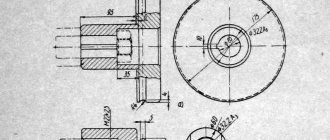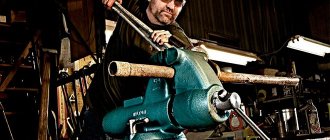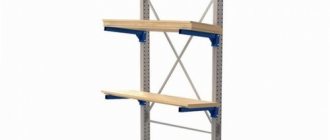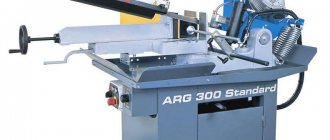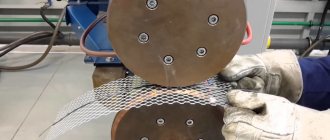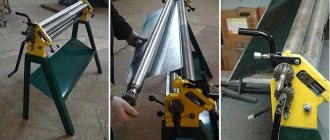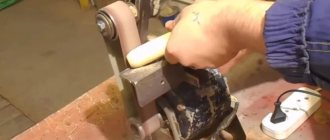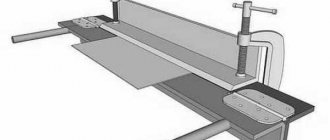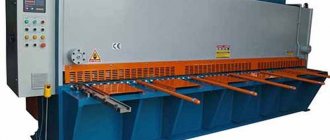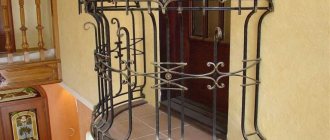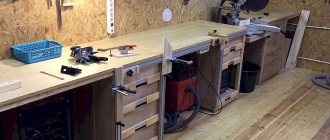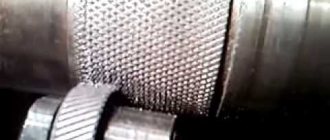The creasing machine is used in tin work for joining cylindrical parts, flanging edges and rolling ribs. This is a mandatory stage in the processing of sheet metal products, so the characteristics of crimping must be approached carefully. The executive tool of the zig machine is rolling rollers of various profiles. Each type of roller is designed to perform a specific job. In production, the machine works in conjunction with a folding bender, a guillotine, folding equipment and rollers.
Classification and design solutions of beading machines
Such equipment (often also called zigmachines) is distinguished by the following characteristics:
- By drive type. Zigmachines are available with electric drive and manual drive.
- According to the number of pairs of rollers for zigmachines – two (IV2714, IV2716) and four.
- According to the control method - with a pedal or using a push-button station.
- According to the power and thickness of the metal being processed. On manual machines (for example, on a manual beveling machine model Stalex RM08), it is impossible to crimp workpieces thicker than 1...1.2 mm, while on driven equipment processing of steel and greater thickness is carried out - up to 4 mm.
- By the presence or absence of a drive reversing unit on the crimping machine (in the first case, you can perform calibrating creasing of the relief, which is often required when processing products made from high-carbon steels). Such possibilities are specified in the passport.
The most popular models of electrically driven zigging machines are two-roller machines of the IVA 27_ _ series with horizontal spindles. Electromechanical beading machines are manufactured in accordance with the technical specifications TU 2-041-94, and include the following components:
- drive motor;
- two-stage rm type gearbox;
- support shaft;
- intermediate gear;
- a pneumatic cylinder (or hydraulic cylinder) that controls the movement of the upper working roller;
- lever drive of the pressure shaft;
- pairs of rollers;
- stop mechanism (for creasing piece workpieces);
- feed unit.
- control systems (pedal, button).
Zig machine design
An electromechanical piping machine works like this. When the engine is turned on, the torque is transmitted through a reduction gearbox and an intermediate gear to the lower support roller, onto which the workpiece, which has previously passed through the straightening unit, is fed until it stops. When the lever system with pneumatic clamping of the equipment is turned on, the latter is fed until it comes into contact with the surface of the workpiece, after which the stop is folded back and the motion sensor turns on the power supply of the strip into the adjusted gap. The relief corresponding to the profile of the tool is formed. If it is necessary to calibrate the resulting profile, the rotation of the engine is reversed, or re-beading is performed, slightly reducing the value of the working gap. To remove the finished product from the working space of the zig machine, it is enough to return the tool to its upper position by turning the cylinder into reverse.
The IV2716 creasing machine can operate as part of a profiling production line; it operates in automatic mode, and a tape or a long strip of metal is used as the initial workpiece.
To facilitate removal of the finished part, the machine is additionally equipped with either a roll winder or swinging reset levers, which are controlled by cams installed at the free end of the support shaft. Standard sizes of serial electric beading machines
| Model | Maximum thickness of processed metal, mm | Bed reach, mm | Maximum zigovka speed, m/s | Minimum quilling speed, m/s | Total drive power, kW | Additional features |
| IV 2714 | 2,5 | 400 | 0,283 | 0,045 | 4,35 | Roller conveyor, device for circular cutting |
| IV 2716 | 4,0 | 500 | 0,283 | 0,055 | 5,3 |
Sheet metal beading: technology and equipment
Creasing (or creasing) is the work of producing surface relief on metal using a continuously rotating tool - a pair of rollers. The profile of the resulting ridges corresponds to the profile of the rollers, and both flat and volumetric workpieces can be used for processing (a typical example is cylinders).
Processing on creasing machines
Advantages of the process and rational ways to use it
The formation of the surface relief on the workpiece is not of an impact nature and can be performed on pressing equipment, but presses require a non-specialized tool - stamps, and the peculiarity of the operating scheme of bending mechanical installations involves an idle stage, when the machine slide moves to its uppermost position. Therefore, zigging on rotary machines has clear technological advantages:
- The simplicity of the design of zigmachines, and, consequently, their low price and low repair complexity.
- Compactness of the equipment (a number of companies successfully design and produce mobile crimping machines with manual drive).
- The process of beading with a rotary tool is characterized by very low energy consumption during operation, so the equipment consumes little electricity.
- On a zig machine, metal processing can be carried out continuously, and therefore the equipment is suitable for plastic deformation of long sheets and strips, moreover, even in automatic mode.
- The technological loads on the crimping tool are low. Therefore, its durability allows long-term use until it is restored. The same set can be reused as a result of regrinding to a new size.
Beading machines are especially effective in small-scale production, when different parts can be produced on the same installation by simply replacing the tool. In particular, IV2714 type zigmachines are used to successfully perform work on folding tubular joints, performing local profiling, applying periodic relief, and even cutting off individual fragments of tape/strip after deformation. Benching is also widely used when working with elements of ventilation systems.
Surface corrugation
How to make staking equipment with your own hands
Purchasing a serial crimping machine, even a manual type, makes sense if working with sheet metal is part of your professional activity. In all other cases, if such equipment is needed to perform simple work around the house, it is better to make it yourself, especially since it is not so difficult to do
What is important is that such a do-it-yourself machine can be made from very accessible and inexpensive materials
Before you start making your own crimping machine, you need to find drawings of such a device, and you can take serial equipment as a basis. This is not difficult to do, since many home craftsmen post machine drawings and even video instructions on the Internet.
Scheme of a crimping machine
Shaft drawing (the upper shaft is made without space for the handle)
Shaft housing drawing
Zig machine bed: height 25 cm, width determined by the height of the box
Thrust-limiting shield: dimensions 18x20 cm, thickness 0.2-0.3 cm. Side struts are welded
A suitable handle can be selected separately, so as not to have to make it yourself
Drawing of machine working rollers
To assemble your beading machine (even a simple manual type machine), you will need to prepare the following structural elements of the machine:
- device housing with a protective casing;
- bracket;
- cylindrical shank;
- two working shafts;
- retaining bolt;
- screw equipped with a folding handle;
- spring type device;
- gear elements;
- directly the videos themselves.
Homemade manual crimping machine
The device is fastened using a special screw, while the shank of the mechanism fits into the cup of the bracket, around which the machine body must rotate freely. The device body is fixed in a certain position using a locking bolt. A spring mechanism, activated by rotating the handle, is responsible for moving the upper shaft of the machine relative to the lower one.
To rotate the working rollers of the machine, another handle is used, which is connected to the working shafts through a gear drive. To make the work of the operator of such a machine safer, the elements of its gear transmission are covered with a protective casing. On the Internet, you can easily find videos that demonstrate in detail the process of making homemade crimping equipment.
Homemade electrically driven zigging machine
The process of processing sheet metal workpieces performed on a crimping machine, the details of which can also be found in the video, is as follows:
- a stop is pre-installed on the workpiece, the position of which can be adjusted using special screws;
- the processed edge of the part is mounted on the lower roller;
- by rotating the handle, the second roller is lowered onto the edge of the workpiece;
- By rotating the handle of the machine, the rollers and the part sandwiched between them are set in motion.
A creasing machine is a special device designed to perform creasing. Benching is a relatively simple process that is performed on sheet metal parts and involves applying continuous ridges and indentations to the parts.
At the same time, for its full implementation, a special device is required - a manual or automatic crimping machine. The modern market offers many similar machines of various modifications. For those who decide to make such a device with their own hands, we provide detailed instructions.
Purpose and design of beading equipment
Before you begin to understand what a crimping machine is, you need to understand why creasing is performed. In the process of carrying out this technological operation, recesses of a semicircular profile are applied to the surface of the sheet metal workpiece. Such recesses, which are called ridges, act as stiffening ribs; their presence on the surface of a thin-walled metal product makes it much stronger. The size of the recesses, for the formation of which the zig machine is used, completely depends on the thickness of the metal used for the workpiece. To select this parameter, which is very important for such a technological operation, special lookup tables are used.
Many modern manufacturers produce crimping machines, the technical capabilities of which allow them to perform a whole range of technological operations. The operations to which sheet metal blanks are subjected during their circular processing include corrugating their surface, cutting and flanging. More powerful and productive, when compared with manual equipment, are electric crimping machines. Due to the presence of a powerful electric drive in their design, such machines make it possible to successfully process workpieces made of thicker sheet metal.
Main parts of the seaming machine
Regardless of whether the crimping machine is equipped with a manual or electric drive, the design and operating principle of such a machine remain virtually unchanged. The main design elements of such machines are two shafts, the axes of which can be located horizontally or at some angle. It is these shafts, rotating relative to each other in the opposite direction, that impart rotation to the working rollers fixed at their end part. The zig machine works, both manual and electric, according to the following scheme:
- the sheet metal blank is placed between two forming rollers of the equipment;
- the machine shafts are brought together, thereby ensuring clamping of the workpiece between the working rollers;
- using a manual or electric drive, the shafts are rotated;
- when the shafts and working rollers rotate, the part sandwiched between them also begins to move; When a workpiece is moved between working rollers with protrusions of the required size and shape, corresponding depressions are formed on the surface of the sheet metal under the influence of plastic deformation.
Types of sheet bending machines and features of their design
Before you start assembling a manual unit with your own hands, you should accurately determine the volume and list of work that the new device will perform in the future. Indeed, depending on the purpose of this unit, the design diagram of the device may also change.
Of all the solutions available today, the simplest sheet bending machine in terms of design is a product that bends sheet metal using a special traverse. Such a device is useful if you are working with material no more than half a meter wide, allowing you to bend the metal at an angle of 90 degrees without additional devices using only the strength of your own hands.
Sometimes, due to the high elasticity of the material, it is quite difficult to achieve an angle of exact 90 degrees. A special spacer (in the figure on the right), which looks like an ordinary strip of metal, helps to correct the situation.
A press brake consisting of a punch and a die is much more difficult to manufacture. In this case, the sheet metal is placed directly on the die, where the desired profile is given to the workpiece thanks to a punch descending from above.
Let's consider the option of assembling a sheet bending machine with your own hands, which will function in conjunction with a hydraulic press. If you already have a press at home, then adding a device for bending metal will not be difficult.
Practice shows that the sheet bending machine, the operation of which is carried out by 3 shafts, was and remains more advanced in operation. Such a unit is sometimes called a pass-through unit. Its main advantage is that the device makes it possible to produce metal blanks with different bending angles. The metal bending machine can be equipped with either an electric or manual drive, allowing craftsmen to implement a wide variety of designs.
A broaching sheet bender can be additionally equipped with a traverse, a clamp and a support, allowing it to be used for manual bending of material. Machines of this kind are equipped with various shafts, which can always be purchased separately, making the device more versatile.
Profiled rollers are used, as a rule, to give the desired angle to elements of roofing structures, be it flanges, ridges, gutters, valleys, etc.
Rollers with a smooth working surface are used in most cases when it is necessary to carry out tin work, for example, to make sections of pipes of larger diameter or to bend workpieces.
Design Features
The classic design has the following features:
- The main structural element can be called a combination of two plates. Many manufacturers create these plates using the waterjet cutting method. The method under consideration has high accuracy.
- In the formed space between the two plates there are two shafts, which are the main elements in contact with the workpiece.
- Of the two installed shafts, the upper one is movable. Its movement occurs due to a special screw-type clamp. Note that a high-quality homemade zigging machine should have a uniform effect on the entire workpiece, since only in this case a high-quality zigging is obtained.
- The main parameter that can be set using the control unit, manual or automatic, is the zigging depth.
The shape of the ridge can be different, depending on the type of installed rollers. Therefore, when creating a crimping machine with your own hands, you should provide for the possibility of replacing the rollers.
Rollers of creasing machines
Design features of zig machines
One zigovochny device is structurally not too different from another. Their main elements - shafts - are located horizontally, vertically or at an angle. Forming rollers are mounted on the shafts, and the workpiece is secured between them. Due to the opposite movement of the main elements, uniform depressions appear on the metal. With their help, the necessary connection is made.
When choosing a crimping machine, you need to pay attention to the following technical characteristics:
- type of drive;
- diameter and overhang of rollers;
- the number of attached pairs of these parts;
- permissible metal thickness;
- machine size.
The smallest rollers are 50 mm in diameter, their number varies from four to six pairs.
An important indicator is roller overhang. It is better to purchase a machine with a maximum reach - up to 350 mm. This will expand the capabilities of sieving equipment.
The permissible thickness of the metal sheet is from 0.5 mm to 4 mm. The crimping machine will not take up much space (with the exception of CNC machines). Such a device can weigh from 17 to 300 kg.
Before starting work, the workpiece is fixed between the shafts and the handle is turned. On manual machines, due to their low power, it may be necessary to pass the workpiece through the rollers several times.
- https://met-all.org/oborudovanie/prochee/zigovochnaya-mashina-ruchnaya-zigovka-svoimi-rukami-chertezhi.html
- https://stankiexpert.ru/stanki/gibochnye-stanki/zig-mashina-svoimi-rukami.html
- https://metalloy.ru/stanki/zigovochnaya-mashina
- https://stanokgid.ru/metall/ruchnoj-zigovochnyj-stanok-svoimi-rukami.html
- https://prostruky.ru/instrumenty-i-oborudovanie/listogib-svoimi-rukami-instrukciya-i-chertezhi-dlya-samostoyatelnoj-sborki.html
- https://promzn.ru/stanki-i-oborudovanie/izgotovlenie-zigovochnogo-stanka.html
This is interesting: Pellet machine: types and features of machines for the production of pellets
Technical characteristics of hand rollers
The diameter of the shafts is 48 mm. The length of the working surface of the shaft is 96 mm. The length of the working surface of the rollers is 20 mm. Number of replaceable rollers - 12 pcs. Adjustable shaft offset - 0....5 mm. Overall dimensions without handle - 241x125x245 mm.
Weight - 12.5 kg.
Manufacturing hand-made jewelry rollers according to drawings will help you save 50% of the cost of similar factory ones.
Additionally, you receive pyramid drawings for stretching the sizing of the rings. By turning the handle you can give the ring the desired size. Sizes from 13mm to 24.5mm according to standards adopted in Germany and Russia.
Source: https://sense-life.com/tekhnologiya/chertezhi-ruchnyx-valcov-dlya-yuvelirnyx-rabot/
Types of zig machines
Beading machines differ in the type of drive:
- manual;
- hydraulic;
- electromechanical;
- with CNC control.
A manual creasing machine allows you to work with thin sheets, no more than 1.2 mm. The working shafts on which the rollers are placed are brought together using a special handle. The shafts also rotate manually. The crimping machine is secured with a clamp to a stable horizontal surface. Its advantage is mobility and compact size. The disadvantage is that the operator must simultaneously hold the sheets and turn the handle. Which requires some management skills.
Hydraulic and electromechanical equipment bends sheets up to 4 mm thick; it is used in large industries. The rotation of the shafts occurs due to the motor, and the frequency converter allows you to change the operating speed. The equipment is controlled from a remote control or pedal, completely freeing the operator’s hands. The main drive is protected from overload by a special mechanism. Hydraulic machines are made only stationary; the pressure roller is lowered by means of a hydraulic cylinder, easily bending thick metal sheets. The rollers are rotated by an electric motor; its combination with a hydraulic cylinder ensures maximum performance with lower power consumption than electromechanical ones.
How to choose?
The zig machine can be used in a wide range. For example, using the device, you can process the edge of a metal on a product, you can also perform corrugation of a sheet, flanging it, applying stiffeners, including for a pipe, cutting and rolling rollers.
In order for the device to work without failures, you need to choose it correctly. To do this, you first need to study the characteristics of the product in question. In this case, be sure to take into account what metal you are going to work with, as well as the number of orders.
As has already become clear, you need to look at one main criterion - the thickness of the material being processed, as well as the roller overhang. Remember that the thickness of the metal surface is the most important issue. For example, a manual machine can process a product that has a thickness of no more than 1 mm, and a power machine can handle metal that has a thickness of about 2 mm or more.
Be sure to pay attention to the protrusion of the rollers. What it is? There is a certain distance between the forming rollers and the thrust plate
This parameter is called roller overhang. It is this factor that is responsible for the depth of processing of a metal surface or pipe. The greater the roller overhang, the more technical capabilities the machine has.
The type of drive also matters.
Manual machines have their advantages. They are compact, mobile, easy to use, and have a low price. They don't need electricity. With their help, you can process thin-sheet products. They are used at height, that is, directly on the roof in the manufacture of the necessary components for forming the roof. There are also disadvantages. The shafts rotate manually, and the specialist quickly gets tired. You can only work with thin material, and these products require installation exclusively on a horizontal surface.
Electrically driven zig machines are powerful machines. Some of these units can handle metal surfaces that are 8mm thick. The design is quite stable. Here the shafts rotate using an electric motor. This machine allows you to change the speed of work. The processed products are of excellent quality.
Safety is another plus. All work is performed from the control panel or pedal method. Naturally, such a device is highly productive. Among the disadvantages are the high cost and the mandatory supply of electricity to the machine. By the way, Russia, as a manufacturer, can offer fairly high-quality models that are no different from foreign ones.
How to make staking equipment with your own hands
Purchasing a serial crimping machine, even a manual type, makes sense if working with sheet metal is part of your professional activity. In all other cases, if such equipment is needed to perform simple work around the house, it is better to make it yourself, especially since it is not so difficult to do
What is important is that such a do-it-yourself machine can be made from very accessible and inexpensive materials
Before you start making your own crimping machine, you need to find drawings of such a device, and you can take serial equipment as a basis. This is not difficult to do, since many home craftsmen post machine drawings and even video instructions on the Internet.
Scheme of a crimping machine
Shaft drawing (the upper shaft is made without space for the handle)
Shaft housing drawing
Zig machine bed: height 25 cm, width determined by the height of the box
Thrust-limiting shield: dimensions 18x20 cm, thickness 0.2-0.3 cm. Side struts are welded
A suitable handle can be selected separately, so as not to have to make it yourself
Drawing of machine working rollers
To assemble your beading machine (even a simple manual type machine), you will need to prepare the following structural elements of the machine:
- device housing with a protective casing;
- bracket;
- cylindrical shank;
- two working shafts;
- retaining bolt;
- screw equipped with a folding handle;
- spring type device;
- gear elements;
- directly the videos themselves.
Homemade manual crimping machine
The device is fastened using a special screw, while the shank of the mechanism fits into the cup of the bracket, around which the machine body must rotate freely. The device body is fixed in a certain position using a locking bolt. A spring mechanism, activated by rotating the handle, is responsible for moving the upper shaft of the machine relative to the lower one.
To rotate the working rollers of the machine, another handle is used, which is connected to the working shafts through a gear drive. To make the work of the operator of such a machine safer, the elements of its gear transmission are covered with a protective casing. On the Internet, you can easily find videos that demonstrate in detail the process of making homemade crimping equipment.
Homemade electrically driven zigging machine
The process of processing sheet metal workpieces performed on a crimping machine, the details of which can also be found in the video, is as follows:
- a stop is pre-installed on the workpiece, the position of which can be adjusted using special screws;
- the processed edge of the part is mounted on the lower roller;
- by rotating the handle, the second roller is lowered onto the edge of the workpiece;
- By rotating the handle of the machine, the rollers and the part sandwiched between them are set in motion.
A creasing machine is a special device designed to perform creasing. Benching is a relatively simple process that is performed on sheet metal parts and involves applying continuous ridges and indentations to the parts.
At the same time, for its full implementation, a special device is required - a manual or automatic crimping machine. The modern market offers many similar machines of various modifications. For those who decide to make such a device with their own hands, we provide detailed instructions.
Classification of serging equipment by drive type
The simplest, both in its design and in its operating principle, is the manual zigovochny machine. All manipulations with such equipment, as its name suggests, are carried out manually. Such manipulations, in particular, include: pressing shafts with working rollers, for which a special handle located in the upper part of the device is used; scrolling the rollers together with the workpiece sandwiched between them: this action is also performed using a special lever-type handle.
To effectively use the simplest manual type crimping machine, certain skills and dexterity are required, since its operator must simultaneously turn the handle and hold the workpiece in the required position, thereby using both hands. Due to the low power of the drive installed on it, a manual creasing machine can be used for processing sheet blanks whose thickness does not exceed 1.5 mm.
Manual crimping machine is suitable for occasional use in the home workshop
A more powerful, productive, but also more expensive in terms of cost is an electrically driven staking machine. Such zigging machines are most correctly classified as electromechanical equipment, since their design also includes a manual mechanical drive, which ensures compression of the sheet workpiece between the working rollers. Due to the electric drive of such equipment, the working rollers rotate and, accordingly, the rotational movement of the workpiece being processed.
The electric drive of the machine is switched on and off using a foot pedal, so that both hands of the operator always remain free to manipulate the workpiece. The presence of an electric drive, which is equipped with such beading machines, as mentioned above, significantly increases their productivity, which makes it possible to successfully use these machines to equip enterprises producing metal products in large batches. In addition, the power of such a machine allows it to be used for processing sheet metal workpieces, the thickness of which reaches 5 mm.
Electromechanical creasing machines, as a rule, can be equipped with additional devices for processing workpieces of complex configurations
Sealing machines can also be equipped with a hydraulic drive, which further increases the power of the equipment. The technical capabilities of such machines make it possible to successfully use them for processing sheet metal of even fairly significant thickness. The hydraulic drive of this type of beading equipment is responsible for pressing the working rollers to the surface of the workpiece, and their rotation and, accordingly, the movement of the workpiece is provided by an electric drive mechanism. Despite all the advantages that hydraulic crimping machines have, they also have disadvantages: large overall dimensions and significant weight, which is why such equipment is mainly used by large manufacturing enterprises.
Design and principle of operation
The zig machine consists of several elements:
- lower, upper shaft;
- handle for rotating shafts (for manual machines);
- screw for adjustment;
- rollers with the help of which parts are processed;
- gears transmitting rotational force between moving shafts;
- housings made of impact-resistant materials;
- cast bed for stable holding of the machine.
Regardless of whether the installation is equipped with an electric drive or not, there are no significant changes in the design or operating process. Zigovka is carried out in several stages:
- The parts are fixed between movable rollers.
- The shafts are aligned to securely hold the workpiece.
- The operator begins to rotate the handle or starts the electric drive.
The workpiece begins to rotate behind the shaft. The depressions are formed under the pressure of the protrusions on the rollers.
Machine structure (Photo: Instagram / stankoprom)
Operating principle of a metal rolling machine
The main component of the machine equipment is the cast frame. It can be steel or cast iron. A special deformation mechanism is installed on the frame, which consists of 3-4 rollers. Three-rollers are usually used. Two rollers do not move; the third roller rotates during operation.
In addition, the movable shafts can move vertically.
The roller is fixed on top of the frame according to a scheme that allows you to quickly remove it if necessary or quickly adjust it for the production of pipes with different cross-sections. This structural element is adjusted using a single thumbscrew.
The metal rolling machine has a long service life
If the work rollers have grooves , you can bend them:
- Pipes;
- Rods;
- Thick wire.
Manual metal bending equipment traditionally has 3 rollers, but there is a type of pipe bender with 4 rollers. But hydraulic machines are always created with 4 rolls.
Making pipes on any unit is quite simple:
- Clamping the sheet with a special handle on the machine equipment between the shaft in the middle and at the edge.
- Pressing the workpiece with the third roller.
- Rotate the roll manually or start the engine.
Passing through the rollers at a certain speed, the metal workpiece bends at the required angles. To build pipes or gutters at home, you need to use a manual unit. By and large, there is no need to even purchase it (although their price is low), since you can assemble a homemade machine and use it to strengthen the profile pipe.
Making at home
If you do not want to buy a factory-made crimping machine, you can make it yourself. This option is suitable for those who work with metal in home workshops and in limited quantities. For industrial enterprises, it is better not to use self-made equipment.
One of the advantages of a homemade machine is its simplicity and low cost of production. All the main parts can be easily found on your farm or purchased on the market. Of course, the number and nature of the parts depends on the type of device you are going to make. There are several options for producing a zig machine at home. We offer one of them.
To create the device you should prepare the following parts:
- Bracket.
- Working shafts (2 pieces).
- Cylinder shank.
- Device body.
- Protective cover.
- Device with a spring.
- Locking pin.
- Gear parts.
- Screw with folding handle.
- Rollers.
The device can be secured using a special screw, but this should be done in such a way that the shank of the mechanism fits into the bracket. The body of the device must be fixed in one position using a locking pin. Using the handle, you can regulate the movement of the apparatus shafts.
The rollers of a homemade zig machine are driven by another handle and by means of a toothed belt drive. When creating your own machine, be sure to ensure that the transmission elements are covered with a special casing.
Such a structural element will certainly make the operator’s work safer. For detailed information, watch the corresponding videos, of which there is no shortage on the Internet.
Video: Homemade manual ZIG machine.
What do you need to know when working with a homemade zig machine?
A zig machine made independently is no different in operating principle from a factory machine, but still has some nuances that must be taken into account. These are such as:
- The part to be processed must be very securely fixed.
- The prepared workpiece must be placed between the rollers and secured with a special stop.
- The process involves adjusting the upper roller, which is operated by a handle.
To avoid injury, be sure to cover all parts of the rotating mechanism with a protective cover. One of the most important advantages of this equipment is that when used, the material used is not exposed to high temperatures.
And also no additional financial costs are required, for example, there is no need to use fuel or large amounts of electricity. And if you use a manual zig machine, then only physical strength is required.
Areas of application for creasing equipment
Equipment designed to perform beading, even though the name of such a technological operation is familiar mainly to metalworking specialists, is actively used in various fields of activity. Sealing machines are practically indispensable for the manufacture of elements of roofing structures, in particular, for the formation of their edges.
Examples of drainage elements made on a crimping machine
It should be noted that in the construction industry, bending machines have found very wide application. Using such machines, in particular, the following elements of building structures and communication systems are made from sheet metal: parts of drainage and air duct systems, insulation for heating mains, etc. In the construction industry, manual staking equipment is predominantly used, since it is characterized by its small dimensions and insignificant weight, does not require an electrical supply for its operation and can be used almost anywhere.
The creasing machine can also be used to reliably connect cylindrical workpieces made of thin sheet metal together. Rollers for equipping a zig machine of this type, when a cylindrical workpiece passes through them, form locks on it, with the help of which the two parts are connected.
Rolling the lock on the air duct elbow
When making connections using locks, unlike welding, there is no thermal effect on the metal parts, which eliminates the possibility of their warping. In addition, such a machine, which you can also make yourself, does not require any additional consumables for its use.
To expand the functionality of a staking machine, including a manual one, it can be equipped with additional working parts. Machines equipped in this way can be used not only as creasing equipment, but also as bending and profiling equipment. Modern creasing machines for industrial use are often equipped with automated control systems, which increases their productivity and accuracy of technological operations performed with their help.
Special attachments allow you to make folds for connecting thin-walled pipes
This is interesting: Elements of artistic cold forging - photos, videos, sketches
Application area
Most often, crimping machines are used in the construction industry. Using such a device, it is possible to produce a whole range of simply irreplaceable structures: elements of air duct systems, drainpipes, spare parts for heating mains. In this field of activity, manual creasing machines are mainly used. They are relatively cheap and have small dimensions. In addition, you do not need to supply electricity to use them.
Crimping machines are often used to process cylindrical parts. The rollers of such a machine, while passing through the cylinder, make special locks on it, to which other parts are attached. This processing method has less negative impact on the workpiece than the welding process. Another advantage of the zig machine is the lack of need for additional consumables.
In addition, a classic crimping machine can be enhanced with additional equipment that will significantly expand its functionality. Using a modified zig machine, you can perform metal bending and profiling. Zig machines can be manual or equipped with an automated control system.
Description of technology
To create a relief image on a thin metal sheet, modern equipment is used - a crimping machine. It is equipped with special rollers, which leave special grooves (ridges) during the process. They can be either flat or have the required volume.
Several operations are performed using a zigging machine, including:
- cutting;
- corrugation;
- flanging.
Depending on the power, the equipment can process metal sheets of different thicknesses. The least powerful are manual zig machines; they are capable of performing operations on metal with a thickness of 0.3 to 1 mm. Electric ones apply relief on thicker sheets - up to 2 mm.
Three types of machines are used for creasing:
- manual zig machines;
- electrically driven equipment;
- hydraulic mechanisms.
The principle of operation in all three types of equipment is the same, only the power and performance differ. There is one more parameter that is important when choosing machines - the location of the shafts on which working rollers with the desired type of relief are put on. The shafts can be positioned horizontally, vertically or obliquely.
The operation of applying a zig to a metal surface is not difficult in itself, but its execution requires care and adherence to technology, because the further strength of the product depends on the correctness of the processing.
The step-by-step process of applying relief looks like this:
- the workpiece is placed on the working surface with the lower roller, the raised upper shaft with the roller on is lowered from above;
- the part is fixed with special clamping screws;
- for reliable fixation and deeper pressing of the relief, a special stop is used;
- powerful electric and hydraulic machines are used to process durable steel sheets of large thickness;
- when applying relief to sheets of soft metal (aluminum, copper alloys), increase the distance between the ridge grooves and their radius;
- the shafts, rotating in the opposite direction to the rollers, exert pressure on the workpiece, as a result of which relief depressions appear.
If the relief is not clearly pronounced after the first operation, it is repeated several times. Metal beveling is considered completed only if sufficient depth of relief is obtained.
Price
The cost of factory models of jewelry rollers, which can be equipped with either manual or electric drive, depends on their functionality and is in a fairly wide range. The most budget models, which in their functionality resemble homemade devices, cost about 6 thousand rubles. As a rule, such models are miniature desktop devices without additional functions that allow processing products of limited width and a certain configuration. Naturally, on the working surfaces of such devices (which, as a rule, have manual drives) there are no grooves, which are called streams.
Professional electric rollers with a cast iron gearbox will cost about 200 thousand rubles
Rollers for jewelry production, which are in the middle price range, cost 20–30 thousand rubles. These devices are the most popular. Thanks to the larger number of working shafts, such models, in comparison with the most budget-friendly ones made by hand, are distinguished by a longer working surface, due to which the impact on the workpiece is ensured. If for rollers made by yourself and belonging to the budget category, the length of such a surface is about 30 cm, then for more functional models this parameter reaches 1 meter.
The cost of the most expensive and truly functional roller-type devices used in jewelry can reach up to 1 million rubles, and on average it is in the range of 100–300 thousand rubles. An alternative to purchasing them, which also involves quite large expenses, is the services of specialized companies that have such equipment at their disposal.
Classification
There are several types of machines for bending profile parts. They differ in type of design, level of complexity, power and other capabilities. Let's take a closer look at them.
Electrical
A special feature of electric machines is the feeding of the pressure roller using an electric drive.
Similar designs are found in large workshops, since they mainly have a stationary structure designed to work with massive parts.
However, there are also compact options adapted for bending small cross-section profiles.
Such machines are successfully used in small workshops or at home. The degree of accuracy of electric roll forming machines is directly related to their size and type of radius control. Electromechanical structures are adjusted by the operator almost manually, but more complex samples undergo digital control of the magnitude of the impact and display the parameters on the display. The higher the level, the greater the weight of the machine and its cost.
Hydraulic
These machines are used for bending massive profiled elements on an industrial scale.
The size and weight of such equipment require a strong concrete base, which allows use only in production conditions.
One of the common types of products of such machines are elements of sewerage or water supply systems.
Hydraulic machines require connection to the power supply network and are serviced only by trained specialists with appropriate approval. Working with such equipment eliminates the need for physical force and provides high-quality and accurate bending. The operation of hydraulic profile benders is characterized by simplicity, the ability to provide significant productivity, and high speed of obtaining results.
Manual
Manual, or mechanical, profile benders are considered affordable and simple devices. They are compact, relatively lightweight, and can be moved within the workshop without the use of auxiliary mechanisms. Manual designs have limited functionality, since their operation requires the participation of the user’s physical strength. In addition, they have a number of disadvantages:
- work only with thin profile types;
- the duration of the process compared to other types of machine design increases significantly;
- poorly controlled radius of deflection of the part;
- difficulty or impossibility of performing several bends of a given size on one part.
Despite these disadvantages, hand-made designs are common and popular among home craftsmen, as they have the necessary properties for self-production:
- compact dimensions;
- simplicity of design;
- availability of parts and components;
- reliability, maintainability.
People who often use manual profile benders achieve considerable success and produce results of a given accuracy.
Roller types
There are several types of machines:
- Manual rollers are the most convenient and practical device for deforming materials. There are no difficulties in working with the device; in addition, such machines do not need to be connected to a network. Clamps and feed rollers operating with a chain drive are attached to the main frame.
Profile rollers, manually driven, are most often used for single production, rather than for continuous production. Such devices offer a number of advantages:
- durability, reliability of the design and ease of operation;
- small size of the rolling machine, due to this it takes up little space;
- simple adjustment of the lower and rear rotating shafts;
- the upper shaft is removed;
- low price of the machine.
Manual jewelry rollers are widely used by jewelers to roll and roll flat metal blanks and wires to give them the desired shape. The working cylinders of jewelry rollers are made of wear-resistant carbon alloy steel. These rollers are powder coated to protect them from corrosion.
When working with the rollers of a hand-held device, additional effort must be applied, since hand-held machines do not operate on electricity and the main guiding mechanism in them is a special pipe. Small metal products are suitable for processing on such machines.
- Hydraulic rollers - hydraulically driven machines are highly powerful. The rolling machine is rated by professionals as the highest quality and most productive unit. However, it is quite weighty, and having installed it once, it is unlikely that you will be able to move the machine from place to place on your own without outside help.
- Electric rolling machines have the highest productivity due to the operation of an electric motor, which allows you to quickly deform the pipe between the rollers. The operating principle of this model resembles a manual one, but there is a motor. Such equipment is often used in industrial production and has many positive reviews from consumers. The only negative is the overpriced electromechanical equipment.
Rolling machines in a home workshop or garage should be:
- mobile. Such a machine should be light in weight for ease of movement;
- taking up little space;
- low-power and energy-saving. A 20 kW machine does its job very quickly, but consumes a huge amount of energy. The wiring in the house simply cannot withstand its work. As an option at home, you can use rollers with a power of up to 1500 Watts, as well as manual ones.
If, for one reason or another, none of the above options for rolling machines suits you, then you can also make the rollers yourself, because few serious repairs can be done without this machine.
DIY SIG machine
Review of a homemade SIG machine
This SIG machine was developed by the author of the YouTube channel “Nikolai Chernak”. It is based on 2 shafts with a diameter of 35 mm. Installed in bearing housings. The lower shaft is stationary, the housings are tightly welded to the racks, and the upper shaft is movable - it rises up quite high. But you don’t need to lift it like that - it’s convenient until the engagement teeth come out.
When planning, it was taken into account that the axis of rotation is closer to the teeth - but not too much. Because if you place it closer, the body gets stuck. Therefore, it is designed like this: closer to the teeth, at the same time on the edge of the body, so when opening, nothing interferes with anyone.
A gear wheel is used at the rear - a gear pair - it was taken ready-made from the wheel beading mechanism. Previously, during the Soviet Union, kits for passenger cars were sold - trimming, disassembling wheels. I took a gear from it. The gear ratio turned out to be good - easy to rotate.
The steering rod of the car is used in the mechanism for opening the impellers. Convenient – ready-made hinge, just welded, that’s it. Let's weld the screw on the hinge to avoid a break here.
The handle is also made by hand from old car parts; at the end there are balls from steering tips. There is a part feed limiter, i.e. letting the lambs in, you can use it. Parts from shock absorbers were used. Hub of a Minsk motorcycle. To avoid sharpening, motorcycle parts are often used.
The working rollers are made to be removed separately from the hubs. If you unscrew the three screws, the upper part of the impeller is removed. And the hub always remains screwed on. But it has movement along the key. There is a corkscrew. As a result, there is no need for very thick blanks during the production of new rollers. Having narrow workpieces on this ZIG machine, you can grind rollers of different configurations.
Continuation about the SIG machine from 6 minutes.
Zig machine with electric drive
Profile depth 7mm, steel 0.7 – 1.2mm. The serging machine has been ordered and is being tested in operation. It shows what parts it can process and what modifications are required to improve functions.
Sealing machine made of gears and rods
The base, that is, the frame should be as rigid as possible. Here is the original version without reinforcement (stiffeners). Discussion
- Hello. Were your fears confirmed or not? I saw about reinforcement in your next video, but how are things going with attaching the rollers? Are they subject to bending?
- Paul Sazhin Hello. Excellent with fastening the rollers. But I will further strengthen the frame since I need to roll a 1.2mm sheet, it moves a little).
- It turned out well, but what car did the shock absorbers come from? Or what is the length and diameter of the rods? Of course, the frame should be strengthened, and it’s better to place the rollers on dowels (or at least on pins), otherwise there is a possibility of scrolling.
- Thank you! From BMW three. Yes, the frame was strengthened, the rod diameter is 22 mm. The throat turned out to be 280 mm. It's too small and narrow for me. It may be enough to make the drive on one upper shaft.
izobreteniya.net
Making a jewelry rolling machine with your own hands
Jewelry rollers are especially indispensable for small jewelry workshops. Designed for rolling metals with high ductility, such as copper, aluminum, gold, silver, brass (without preheating) and less ductile low-carbon steel, duralumin, bronze (with preheating to 60-80 degrees) to give them the necessary
geometry: thin sheet, foil, wire of various sections. The wire can later be used to weave into precious gold and silver chains and lace.
A set of interchangeable rollers allows you to form profiles of wedding ring blanks and give finished jewelry and costume jewelry a “diamond” effect.
cuts" (chains, bracelets, etc.)
Description of rollers
The main working mechanisms of rollers are rotating cylinders. Hot sheets of metal are passed through cylinders and thus the metal is bent. Rolling machines, depending on their purpose, have from 2 to 5 cylinders, and the most common are 3- and 4-roll models.
The third rear shaft is responsible for the bending of the parts, and the radius of curvature, in turn, is determined by the distance between the rear and upper shaft.
Due to sometimes very heavy loads, metal rollers can break, which leads to frequent replacement of machines. When working with iron, it must be heated repeatedly; after the rolling machine, the iron layers are sent to the furnace, heated and rolled again. The reheated iron bars are then sent to the sectioning machine.
Passing through the rollers, the cross-section of the metal decreases and it lengthens. This effect is exerted by the high heating temperature of metal products and the degree of pressure on them.
In order to make a cylindrical product, it is necessary to adjust the rear shaft parallel to the front one. When making a metal cone, the rear shaft must be installed at an angle relative to the front one.
There are models of rolling machines that are much simpler; metal processing can be performed on them by installing them on a table. Such models are less functional, since the device must always be held in place during operation. However, you can use fasteners - this will greatly simplify the rolling process.
The smaller the dimensions of the device, the lower its cost. When choosing a rolling machine, you should consider the size of the largest part to be processed and its thickness.
Modern rolling machines are capable of performing the following functions:
- pipe bending up to 180°;
- working with metal pipes;
- deformation of pipes of different diameters.
Scope of application
Rolling machines have found their application in the production of air ducts, drains, ventilation systems, pipes, and chimneys.
The small size of the machines allows them to be used anywhere and directly at the construction site. Hand rollers do not damage the polymer coating of sheet metal.
The food industry uses crushing rollers, for example, in the production of flour. In the chemical industry you can find sheeting, refining, and bending rollers.
The latter have a number of obvious advantages, such as: reliability, ease of maintenance, high productivity, and a system for adjusting the stroke of the metal sheet.
Machine for strengthening profile pipes
Reinforcement means the formation of ribs at the corners of a square or rectangular profile during rolling on specially shaped rollers.
Pipes with a reinforced profile are characterized by high bending strength and are used to create curved structures of any degree of complexity.
The profile is strengthened using specialized equipment.
Application area
To obtain the desired configuration, profile pipes are sequentially processed on profile strengthening machines, a forging block and a pipe bender.
A pipe bender allows you to bend profile pipes along a longitudinal section along a given radius. Such products are used when installing canopies, gazebos, and canopies.
Rollers for metal
To give sheet metal a cylindrical shape, it is simply impossible to do without a rolling machine. Pipe rollers are most often used in the manufacture of drainage systems.
Rolling machines with forging cylinders carry out cold bending of metal workpieces and belong to the category of rotary models. This equipment can be used to work with thin sheet steel with a thickness from 0.1 to 120 mm.
You can also process ductile metals, rubber compounds and plastics.
The rolling machine is selected depending on the thickness of the materials. Twin-roll rollers consist of two parallel shafts. The upper one, with a small cross-sectional diameter, is often made of high-strength steel, and the lower, with a larger cross-sectional diameter, consists of rubber-coated steel.
The outlet diameter of the pipe depends on the force with which the pressure is exerted on the pipe. Three-roll rollers can be pyramidal, that is, symmetrical, or asymmetrical. Today they are in great demand in the production of ventilation air ducts, round drains, and radius parts.
Three-roll folds are used for processing copper, iron, steel, zinc and other materials.
Four-rollers have an additional roller at the bottom, which simplifies the rolling process.
A sheet of hot metal is placed between the upper and lower cylinders, the front part of which is folded using a bending shaft. During the folding process, the sheet of metal is gradually rounded.
Checking the machine for functionality and fine-tuning
After you have assembled a device for bending sheet metal with your own hands, you need to test it for functionality. To perform test bending, it is better to use a softer metal, which can be a sheet of tin, which bends very well. The sheet is placed on the base of the bending machine and fixed to it using a clamp. When performing test bending, the machine clamp can be temporarily tightened to its base with clamps or threaded rods with overlays can be used for these purposes.
If the position of these structural elements is not entirely correct, it is corrected and only after that they are thoroughly welded to the frame. In order to reliably fix the clamping device of the machine during bending, use bolts protruding above the frame, which must coincide with the holes in the brackets of the clamping mechanism. To install such bolts on the frame, holes are drilled in it into which an M10 thread is cut. The bolts are screwed into such holes from bottom to top, after which their heads are welded to the bottom of the frame.
Installing clamping bolts with springs
To ensure that the bolts installed on the frame easily fit into the holes in the clamping mechanism brackets, they are increased to a diameter of 10 mm. It is better to choose nuts that will screw onto the top of such bolts and thereby fix the clamping mechanism on the frame of the bending equipment in the form of handwheels; this will significantly increase the ease of working with your homemade machine. The clamping mechanism must be pressed out while unscrewing it from the frame. To do this, you can put springs or rubber shock absorbers on the bolts with which it is fixed.
We weld rods to the bolt heads as handles
Having assembled a homemade machine for bending sheet metal using the method described above, you will not wonder how to bend tin or how to bend painted metal: even galvanizing can be processed on this equipment with fairly high efficiency. Meanwhile, such a bending machine also has a number of disadvantages.
- The design of fastening the cheeks and the punch is not well thought out; during the operation of the bending machine, these elements constantly rub against each other and, accordingly, actively wear out. As a result, play occurs in the mechanism, leading to inaccuracies during the bending process. This drawback can be corrected by using bearings in this unit.
- Bending machines of the design described above are not characterized by high productivity and can only be used if it is necessary to perform a small amount of work. To make a more productive manual machine, it is necessary to improve the design of the clamping mechanism.
Homemade bending machine at work
The video is very helpful in making such a machine with your own hands. Typically, many professional tinsmiths who assemble machines for bending sheet metal practically from scrap metal prefer to use homemade equipment in their activities.
Roller-type bending machines, which have a more complex design, can also be made independently. However, no matter what type of machine you are going to make yourself, you should keep in mind that you will operate such equipment manually, so making it too large and powerful does not make sense. If we talk about the features of using roller bending machines, it should be borne in mind that when processing a workpiece on such equipment, its individual sections may be subject to deformation. This is why professional tinsmiths do not really like to work on devices of this type.
DIY jewelry rollers - Metalist's Guide
Jewelry rollers, by their operating principle and appearance, are very similar to the squeezing devices of old washing machines. Such devices, which were installed on washing machines in the last century, simply pressed the washed clothes between two rubberized shafts, squeezing out the water from it.
In jewelry production, rollers are used for rolling and rolling sheet metal, as well as wire and rods.
Making a jewelry rolling machine with your own hands
It is quite difficult to make a rolling machine yourself
A rolling machine (rolling) is a unique equipment that is used in the field of construction and repair work for bending various types of metals.
Where to start making a sheet bending machine
To make a machine for bending sheet metal, you will need a drawing of such a device or its detailed photos. In addition, a number of important factors should be taken into account, such as the force that will need to be applied to use the sheet bending machine, its weight and dimensions (on which mobility depends), cost and availability of components. As a result, we obtain the following initial parameters.
- The maximum width of the sheet that will need to be bent is 1 m.
- Maximum thickness of sheet material: galvanized – 0.6 mm, aluminum – 0.7 mm, copper – 1 mm.
- The number of operating cycles that will be carried out without readjustment or repair is 1200.
- The maximum bend angle of a metal profile, obtained without manual finishing, is 120 degrees.
- It is highly undesirable to use workpieces made of special steels (for example, stainless steel).
- In the design of a sheet bending machine, welded joints that do not withstand alternating loads should be avoided.
- You should limit as much as possible the number of sheet bending machine parts that you will need to order externally, using turners or millers.
It is very difficult to find a drawing of a device that would satisfy all these requirements, but the most successful one can be modified.
Rules for strengthening profile pipes
It is almost impossible to do without a device such as pipe rolling equipment in cases where you need to carry out repairs yourself, which will require the use of curved pipes.
To do this, you need to purchase a unit of this type or use homemade profile benders, the design of which is quite simple.
It also makes sense to ask the question of how to make a machine for bending metal because store-bought products are expensive, so buying them (especially if they are needed only for home use) is not always rational. In order to make high-quality homemade rolling, you can study the theory, watch a video on this topic, but the main thing is to listen to the advice of those who have already achieved excellent results.
When using the machine, please follow safety instructions
Naturally, to build your own rollers, you need:
- Have relevant knowledge;
- Have certain skills in manufacturing and using various technical devices;
- Prepare drawings and materials.
Do-it-yourself rollers can even be created from improvised building materials, which are almost always available in any garage or workshop at home. Moreover, such equipment, if everything is done taking into account all the recommendations, will work no worse than products from the store.
Features of machines for metal
Without a rolling machine, it is impossible to shape sheet metal into a cylindrical shape, and pipe rollers help create a drainage system . Machines with forging cylinders are needed for cold bending of metal blanks; also, thanks to rollers, you can process:
- plastic;
- ductile metal;
- rubber compounds.
You need to choose one or another machine depending on the thickness of the metal:
- Twin-roll rollers include two parallel shafts, the upper one has a small cross-section and is made of high-strength steel, and the lower one has a large cross-section and is made of rubber-coated steel. Depending on the pressure force of the pipe, its outlet diameter is selected;
- three-rollers can be symmetrical or asymmetrical ; they are often used in the production of ventilation, round gutters and radius parts. In addition, three-roll rollers are used when processing products made of copper, iron, steel, zinc, etc.;
- four-roll designs are equipped with an additional roll at the bottom to simplify the rolling process.
The most common rollers are three-roll and four-roll. Thus, three-rollers have the following distinctive properties:
- a sheet whose width is less than 6 mm will slip between the shafts;
- the sheet rolling speed should be a maximum of 5 m per minute;
- it is difficult to operate the machine due to the lack of exact coordinates of the metal clamping point;
- affordable price.
But four-roll rollers have the following characteristics:
- the rollers are securely coupled and the risk of sheet slipping is minimized;
- rolling speed can exceed 6 m per minute;
- the work process is fully automated;
- the price is high.
This is interesting: Metal scraper: purpose and types of scraping tools
Master Class
each of us is a Master
Micro rollers for craftsmen working with wire
In works involving wire, flat wire is often required. Hitting several meters with a hammer on a flathuisen is a tedious task, and in this case micro-rollers can help.
Materials: - a pair of identical bearings with an outer diameter from 2.5 to 4 cm; — fastening pin (threaded rod), at least 20 cm long; - a piece of iron or steel pipe with a diameter equal to the bearing diameter or 0.1-0.2 mm larger; - several identical nuts with threads equal to the threads on the stud; - metal plate with dimensions from 40x40 mm.
Tools: - drill; — drill with a diameter of 3 or 3.5 mm; — a drill with a diameter equal to the diameter of the stud or 0.5..1 mm larger; — a hacksaw for metal or a grinder with a cutting disc for metal; - vice; - hammer; - a wrench for the existing nuts.
General types of device:
Take a suitable steel pipe. The diameter should be 0.1-0.2 mm larger than the diameter of the bearing hole or “quite close” - then you may need to jam it with something, for example, a small piece of thin steel wire. We saw off two sections from it, 50..60 mm long. You can do less, the device will be more compact, but it will be more difficult to drill.
I bought a kitchen rail, from which I cut suitable pieces. Since the rail was 2 mm larger in diameter than the bearing hole, we had to make a wide cut along the entire length and “turn it” to the required diameter. If you have a grinder, the operation is quite easy, but with a hand hacksaw you will have to tinker.
We put bearings on the segments, placing them in the center of the segment. The bearings must be put on very tightly, even to the point of hammering them with a hammer or mallet.
If you have a workbench with a small hole (slightly larger than the diameter of the axle), then it is much more convenient to drive the axle into the bearing, and not vice versa.
Take a hairpin with a diameter of 6..8 mm and cut two pieces 10..11 cm long from it.
We fix the axle with the bearing in a vice and drill two holes with a diameter of 0.5..1 mm larger than the diameter of the stud. Small diameter drills usually come in increments of 0.5 - so there should be no problems.
To drill accurately, I recommend first punching the future hole with a core (a nail for concrete or a regular screw will do), then drill it with a thin drill (3 mm). Holding the drill vertically, you can immediately use the same drill to make a hole in the opposite part of the axis.
When drilling, it is necessary to observe as accurately as possible: a) parallelism of the holes to each other; b) the same distance between the holes in both axes. Why? Because if “a” is broken, then the studs will not stand in the same plane, which will prevent the installation of the second axis. And if “b” is broken, then the studs will not be parallel to each other and installing the second axis will also be difficult.
I got caught doing this and had to sharpen the hole in the right direction using a needle file.
We take a metal plate that will serve as a clamp and drill holes in it. The distance between the holes should be as close as possible to the distance between the holes in the axle.
That's it, the machine parts are ready.
1. A nut is screwed onto each stud up to 1/3 of the distance. This will be the lower axle stopper.
Which of your axes will be the bottom and which will be the top is never important as long as rules “a” and “b” are followed. If they are not followed, again it doesn’t matter, because it simply won’t be possible to assemble the structure
